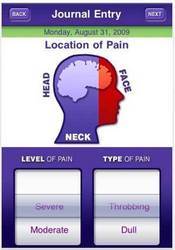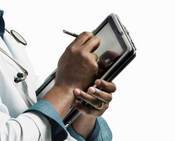Health IT Sees Key Market In Family Caregivers
Mobile devices, personal health records are among technologies most valued by people caring for elderly or disabled family members, finds survey released at CES.


15 Healthy Mobile Apps
(click image for larger view)
Slideshow: 15 Healthy Mobile Apps
Family caregivers who use technology to assist them in caring for their family members or close friends are confident that emerging technologies, like mobile health devices and personal health records, will bring significant benefits to both them and their care recipients.
The "e-Connected Family Caregiver: Bringing Caregiving into the 21st Century" study, which was released Saturday by the National Alliance for Caregiving and UnitedHealthcare, found that among the expected benefits are: saving time (77% believe they would benefit somewhat or a great deal), making caregiving easier logistically (76%), making the care recipient feel safer (75%), increasing feelings of being effective (74%), and reducing stress (74%).
The report is based on an online survey, conducted Nov. 9 to 22, of 1,000 family caregivers who provide at least five hours per week of unpaid care to an adult relative or friend needing help because of a physical or mental illness, disability, or frailty. The study's findings were presented at the 2011 International Consumer Electronics Show (CES) Silvers Summit in Las Vegas.
All caregivers participating in the survey use the Internet or some other technology to help them provide care. Nearly half of the survey respondents have used an electronic organizer or calendar to help them with caregiving (47%), and 11% have participated in a caregiving-related blog or online discussion. Forty-one percent have used another technological device or system -- other than a standard computer or cell phone -- to help them with their caregiving.
According to Richard Migliori, executive VP of business initiatives and clinical affairs at UnitedHealth Group, the survey indicates that caregivers are using technology to make their jobs easier. "As the technology and healthcare industries increasingly use these kinds of tools to improve care in hospitals and doctors' offices, this survey is a reminder that these improvements could be equally helpful where care matters most -- in the home," Migliori said in a statement. "The use of new technologies can be a powerful tool to keep seniors independent as long as possible and support family caregivers."
Not surprisingly, of the 12 technologies evaluated in the survey, the top three were those perceived as having the greatest potential to deliver, monitor, track, or coordinate healthcare, and more than half of the surveyed caregivers said none of the seven potential barriers examined in the survey would prevent them from trying each technology. These technologies are:
-- Personal Health Record Tracking: 77% of caregivers reported that a Web site or computer software that could help them keep track of their care recipient's personal health records, including his or her history, symptoms, medications, and test results, would be very or somewhat helpful to them.
-- Caregiving Coordination System: 70% of caregivers indicated that a shared electronic log for their loved one's doctor appointments and other caregiving needs would be helpful. With this tool, caregivers could request support in their duties, and friends and family members could sign up to help on certain dates and times.
-- Medication Support System: 70% said a device that reminds the patient about his or her prescription medications and dispenses pills when they should be taken would be helpful. This device would also provide directions on how to take each pill and alert the caregiver when the dosages were not removed from the device within a certain time period.

Health IT Boosts Patient Care, Safety
(click image for larger view)
Slideshow: Health IT Boosts Patient Care, Safety
Four other technologies received a strong vote of confidence from caregivers:
-- Symptom Monitor and Transmitter: 70% of survey respondents said an electronic device that would send information such as blood sugar or blood pressure readings to a doctor or care manager to help them manage their care recipient's condition would be helpful.
-- Interactive System for Physical, Mental, and Leisure Activities: 62% of caregivers reported that a TV-based device, similar to a Wii Fit, that would allow the caregiver to create a schedule of gentle physical activities and mental games for the care recipient would be helpful.
-- Videophone System: a phone with video capability or an Internet-connected computer with webcam that allows the caregiver to see the care recipient when they're not able to physically be together would be helpful for 61% of caregivers.
-- Smartphone: 69% of respondents said they would be somewhat or very receptive to using a smartphone for applications to help them with caregiving.
While caregivers expressed enthusiasm for these technologies, the most commonly reported obstacle to adoption was the perception that the technology would be expensive (37%, on average, across the 12 technologies). Despite this concern, almost half of caregivers surveyed thought technology could save them money (46%).
According to Gail Hunt, CEO and president of the National Alliance for Caregiving, the survey prompts caregivers to look ahead and asks them to makes an assessment of emerging technologies that they think will be most useful to them as they focus on the health of their loved ones as well as their own well being.
She also said the economic downturn has had an impact on caregivers and their use of technology, noting that one-third of working caregivers work extra hours or work two jobs to help cover their caregiving expenses, while 50% feel less comfortable asking for time off to attend to their caregiving duties.
"This study reveals caregivers' concern about the perceived expense of these technologies. We need to ensure caregivers understand that many of these technologies are affordable or even free and provide assistance to help them find and utilize these helpful tools."
Respondents said the top three factors that would make it more likely for them to try a technology are: a health professional who is involved with the caregiver or their recipient explained that the technology would be helpful (88%); they saw a how-to explanation showing that it is very simple to install and use (80%); or they were offered a three-year warranty on the technology (78%).
In terms of learning about caregiving technologies, 77% of respondents said they would trust a medical Web site like WebMD or MayoClinic.com; 67% would trust a government Web site like Medicare or the Administration on Aging; 66% would trust a consumer review Web site (66%); and 57% would trust caregiving magazines, Web sites or forums on the Internet.
About the Author(s)
You May Also Like
Smart Service Management
June 4, 2024Tales of a Modern Data Breach: The Rise of Mobile Attacks
June 11, 2024The CIOs Guide to Enhancing GRC in 2024
June 20, 2024







